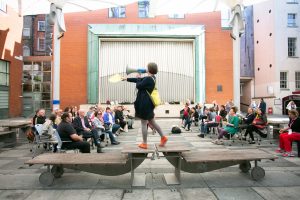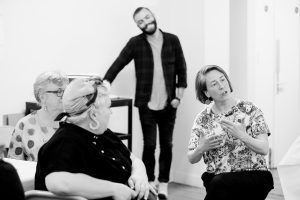
Before joining Creative Producers International I had been working as a visual artist and an independent curator commissioning and presenting work, often in and for public space. For the first 10 years of my art career much of my work looked at how public space was designed and how that design impacts the way that we live. Through my practice I engaged with city council officials, designers, engineers, architects, planners, community activists, and city users to name but a few. I was drawn to CPI because I wanted to take some time to think about how art could affect city change, if at all, and how I might better achieve this desire to impact how our environment is built and used by its citizens.
The first three-week workshop was a whirlwind of amazing people and ideas. The producers in CPI are incredible people: each with their own drive and passion for their cities. The conversations we had in those three weeks coaxed me to think more deeply about what I was doing and why. We talked about the values that we bring to our work and how to find the points of alignment with stakeholders and collaborators within each project.
The sessions that looked at the complexity of the relationships that are built up through a project made in and for the city made me really think about how we communicate with stakeholders: How can we best create a shared understanding and vision for a project that is being developed? As the work I do often involves the participation and collaboration of multiple people, clear communication is important. With this in mind I decided to focus on building skills in the area of stakeholder dialogue and facilitation as part of my development grant.
First, I spent three days in Kent in England with Dialogue Matters, taking part in a course called Stakeholder Dialogue: A good practice approach to participation. The course was fascinating, not least because it had been developed through work in the environmental sector. We looked at contentious issues and how to bring people on seemingly opposite sides of a divide towards consensus and dialogue. The course specifically looked at how to create the space for real engagement with issues, moving from a notion of compromise to co-operative decision-making. I learned a great deal from this approach, looking at how to reduce uncertainty by sharing information to lessen anxiety and conflict within negotiations. I also learned about different techniques and methods to create space for sharing ideas, having many different perspectives voiced, and ensuring that all voices in a process are heard.

Furthermore, I took part in a creative facilitation training course with Partners for Training for Transformation in Dublin. This workshop looked again at different methods of facilitation and the theoretical underpinnings of facilitation. There was less focus on conflict and more attention given to creating an open environment that would draw people together, often seeing each other in a different light.
Finally, I took part in two days of training in life coaching. I had worked with a life coach for an artwork in the past and I was interested in how coaching often uses very specific and powerful questions to draw out information and insights in the person being coached. These powerful questions unearthed ideas and observations that might otherwise not have been brought to light. We talked a lot about asking open questions and clarifying questions that can lead to more information being shared. This can then be used to build a strategy or plan of action to move towards a goal. This has been invaluable in everyday life, working with artists and with stakeholders to understand their perspective, desires and goals in a situation.
I learned a lot about myself during these workshops. As my work often involves working with groups of people and facilitating discussion it was interesting to have my own style of facilitation mirrored back to me, while also challenging me to think about how to moderate my natural facilitation style to different situations and groups. But it also got me thinking about how, often, what I do as an artist or curator isn’t strictly facilitation – I am not an objective bystander in a process: I have a stake in the situation and often have a specific interest in the outcome. It was interesting to consider how to work around this so it might be possible to bring more objectivity into a situation with a group, while also maintaining my own agency within the work.
As an artist and curator and initiator of projects in the city communication is key. Asking the right questions and focusing on what answers are given seems like an obvious and easy task, but when you get down to it can often lead to miss understanding and conflict. The development grant has allowed me to really focus on this core aspect of my work and the work of any producer working with multiple stakeholders, participants and collaborators to effect city change.
